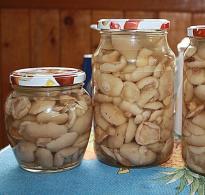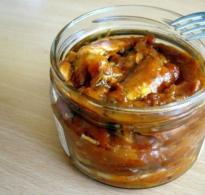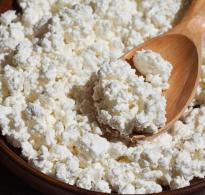What does crème fraîche provide when making a cake? Creme fraiche: benefits, preparation, French recipes
Features of preparing fermented milk product. Composition and calorie content, beneficial properties and harm when consumed. French cuisine recipes. Possibility of using crème fraîche in home cosmetics.
Contents of the article:
Crème fraiche is a fermented milk product, a popular dish in French and Belgian cuisine. In its homeland it is called creme fraiche, which literally translates as “fresh cream”. The color is white, the structure is uniform, does not separate even when heated, the taste is pleasant, refreshing, with a slight sourness. The starting material for preparation is cream skimmed from cow's milk. Traditionally, the fat content is low, the product is produced with 15-28-30%. It is used on its own and as an ingredient in sauces, desserts and hot dishes.
How is creme fraiche made?

There are many options for preparing the dish. Live yogurt, a pure culture of fermented lactic bacteria, curdled milk or kefir are used as starter culture.
How to make creme fraiche:
- Without heat treatment. Cream 33-38% fat is mixed with yogurt, 250 ml per 2 tbsp. l. Mix thoroughly with a wooden spoon, cover with gauze folded in several layers or canvas. A tight lid is not suitable; the product will sour and separate. Leave at room temperature until the contents of the container thicken. This usually takes 24 hours. Mix again and refrigerate for another 6-8 hours.
- With heat treatment. The quantity of products is the same; yogurt is used as a starter. Cream 33% fat is poured into a metal container and heated over low heat, but not to a boil, but to 72°C. It's best to use a food thermometer to avoid overheating. Experienced chefs are guided by the release of steam. As soon as it begins to separate abundantly and becomes opaque, remove the container from the heat. Close with a tight lid and leave to cool for 40-45 minutes. The cream is then cooled using ice or cold water. Be sure to stir when cooling. Pour into a jar, combine with the starter, shake. Cover the neck with gauze and leave to infuse for 3 days in the dark at room temperature. Then mix everything and put it in the refrigerator for 2-3 hours.
If you plan to introduce the tender mass into desserts, add powdered sugar to it before cooling and beat with a whisk. In this case, it will be possible to obtain an airy structure more reminiscent of whipped cream, which is sold packaged in cans.
You can make creme fraiche as a spread for sandwiches. In this case, at the penultimate stage, spices, pepper, salt, garlic, dried and crushed herbs are beaten into it.
It is not recommended to add fresh herbs to improve the taste. The shelf life of a fermented milk product prepared at home on a refrigerator shelf is from 5 days to 2 weeks. If you add fresh juicy greens to improve the taste, you will need to eat it within 72 hours.
Production technology in the food industry differs little from preparing creme fraiche at home:
- The cream is collected from the surface of the milk, having previously beaten it in a separator and cooled it. During separation, cleaning is carried out. Since no further heat treatment is carried out, this step is very important.
- A one-stage sterilization is carried out: placed in a special installation, homogenized and pasteurized at a temperature of 80-90°C, increasing the pressure to 11-17 MPa, and cooled.
- Pour into a vat, where a pure culture of lactic acid bacteria is added. Fermentation is carried out at a temperature of 20-40°C for 18-40 hours. Denaturation of milk proteins must take place in full.
- The resulting product is poured into packages and cooled.
Composition and calorie content of creme fraiche

The nutritional value of the French national dish is low. Consumers are more often offered packaging whose label indicates 15% fat content.
The calorie content of self-prepared creme fraiche is 249 kcal, of which:
- Proteins - 2.3 g;
- Fats - 25.5 g;
- Carbohydrates - 3.3 g.
Creme fraiche contains 15% milk sugar (lactose) and the entire complex of nutrients contained in the raw materials, plus lactic acid bacteria.
Most:
- Calcium- strengthens the structure of bone and cartilage tissue;
- Potassium- normalizes heart rhythm, prevents surges in blood pressure;
- Magnesium- reduces blood glucose levels;
- Sodium- responsible for water-electrolyte and acid-base balance, retains fluid in the body;
- Sulfur- participates in ion exchange and increases the strength of cell membranes;
- Gland- increases the number of red blood cells in the bloodstream;
- Ascorbic acid- increases the body's defenses;
- Vitamin B complex- have a beneficial effect on the central nervous system.
The main role of lactic acid bacteria in the human body is to maintain a balance of beneficial, opportunistic and pathogenic intestinal microflora so that the microflora of the first group - lacto- and bifidobacteria - predominates. If the proportions are violated, local immunity decreases, vitamins and minerals are not absorbed by the body, anemia develops, and the general condition of the body worsens.
The benefits and harms of crème fraiche for humans depend on the type of starter used for production. If pure bacterial cultures were used, the overall effect is rather neutral. When introducing kefir, the maturity of the fermented milk drink should be taken into account, and yogurt can help accelerate peristalsis. However, perception largely depends on the individual characteristics of each consumer’s body.
Useful properties of creme fraiche

The national cuisine product is not used as a medicine, but is introduced into the diet when recovering from debilitating diseases and losing weight. After consumption, satiety quickly sets in, and the feeling of hunger is blocked. A healthy breakfast will provide you with enough energy to last throughout the day.
Benefits of crème fraîche:
- Prevents the development of dystrophic changes in bone tissue, which cause osteoporosis, osteochondrosis and arthrosis.
- Stabilizes the condition of the cardiovascular system. After regular introduction into the diet, the number of hypertensive attacks decreases.
- Stimulates the production of synovial fluid and improves its quality.
- Improves the quality of skin, hair and nail plates.
- Increases the tone of the walls of blood vessels.
- Reduces the likelihood of malignancy in already formed tumors and stops degenerative processes at the cellular level.
Homemade creme fraiche with moderate fat content is one of the best diet options for weight loss. When you lose weight, a large amount of fluid is removed from the body, and useful substances, mainly potassium, are washed out with it. To prevent heart rhythm disturbances and the development of tachycardia, fermented milk products are included in the menu.
Contraindications and harms of creme fraiche

No absolute contraindications to the introduction of national French cuisine into the diet have been identified. It can be given to children at any age, during pregnancy and lactation.
However, the possibility of individual intolerance should also be taken into account. When consumed, crème fraiche can cause harm to patients with celiac disease and allergies to certain types of starter cultures.
You should temporarily refrain from using it during exacerbation of chronic diseases of the digestive organs - pancreatitis or biliary dyskinesia, during infectious processes, the symptom of which is acute diarrhea or increased flatulence.
For patients with a tendency to form phosphate stones in the kidneys and calcium in the lumen of blood vessels, it is advisable to avoid overeating.
Recipes for dishes with creme fraiche

Fermented milk product can be introduced as an ingredient in many dishes.
Recipes with creme fraiche:
- Pancakes with ricotta. The cheese is hung in gauze to drain excess liquid. For the dough, mix 250 g of flour, 1 tbsp into 1.5 cups of milk. l. sugar, beat in 4 large chicken eggs and add some salt. It is better to pour 2 tbsp into the dough. l. melted butter. Beat everything until smooth. You can use a blender. It is advisable to cool the dough well on the refrigerator shelf. Creme fraiche for filling, a quarter cup, mixed with lemon zest and lemon juice. To make lemon filler, just take a teaspoon of zest and a tablespoon of juice. To season the ricotta, mash 2 tsp in a bowl with a fork. chopped dill, Shiite and regular green onions, parsley. Add a little salt, pepper and zest. Combine with the main product and bring to homogeneity. The frying pan is heated, greased, before pouring the dough, with butter using a feather whisk, pancakes are baked on both sides. Grease the finished pancakes with a layer of ricotta, lay out 2-3 thin slices of salted salmon and 2 red onion rings, pour over lemon crème fraiche and roll them into envelopes. Before serving, sprinkle with chopped dill.
- Mint soup. To replicate the delicate taste of French cuisine, no substitutions of ingredients are made. Heat a thick-walled pan, add 50 g of butter, melt, add 1 tbsp. l. olive oil. Add chopped shallots (2 pieces) and celery (1 stalk). Salt and pepper to taste, cover with a lid. Simmer for 15 minutes until all ingredients are soft. Pour in 600 ml of pre-cooked chicken broth, bring to a boil, reduce heat. Add fresh green peas, 350-400 g, and cook until tender. Remove the pan from the heat, add mint (1 tbsp) and creme fraiche (4 tbsp). Lower the immersion blender and bring the soup to a creamy, homogeneous consistency.
- Puree with rosemary oil. When preparing a dish, ordinary salt is replaced with sea salt. Turn on the oven - you need to preheat it to a temperature of 190°C. The baking sheet is covered in advance with foil or parchment for baking. Mix in a separate bowl a finely chopped onion and 3 pcs. fennel, generously add salt and season with 3 tbsp. l. olive oil. Place the “salad” on a baking sheet, sprinkle with ground black pepper, and bake for 15 minutes. Boil the potatoes after peeling them. While the tubers are boiling, make the sauce. Combine 100 g of melted butter, half a glass of creme fraiche and rosemary - 1.5 tbsp. l. The sauce and roasted fennel are mixed into the mashed potatoes. Before serving, each portion is heated in the microwave.
- . 100 g of finely chopped fresh mushrooms (milk mushrooms, white mushrooms, chanterelles or boletus mushrooms) are fried in a frying pan with thyme and olive oil until golden brown. Beat eggs (3 pieces) in a separate bowl with salt, creme fraiche (0.5 cups), black pepper and green onions. Pour the egg mixture over the frying mushrooms, cover the pan with a lid and bring the dish to readiness.
- Custard. Beat a glass of creme fraiche, 50 g of powdered sugar, an egg, and any berries in a blender bowl. You can replace the berries with lemon zest, fruit puree, and add vanillin.

Features of French cuisine are refined and delicate dishes. Therefore, it is not surprising that the chefs of this country are thinking about improving the recipe for the popular fermented milk product - sour cream. After heat treatment, the new product does not delaminate, allowing for improved presentation.
Features of using crème fraiche for preparing homemade cosmetics:
- Rejuvenating French mask. Mix the fermented milk product with blue clay in a 1:1 ratio, add vitamin E in the form of an oil solution.
- Anti acne. To prevent the appearance of acne, you should carry out a healing course by mixing 2 tbsp. l. delicate dish and fresh cucumber puree. 1 tsp is used as the active ingredient. calendula infusion.
- Nutrient. Contains creme fraiche, honey and rice flour. The proportions of the mixture are 2 parts creme fraiche and one part each of the remaining ingredients.
Watch the video about creme fraiche:
Making creme fraiche at home is quite simple. There is no need to buy a specific starter or create special conditions. With the help of a French cuisine product, you can always feed your family healthy breakfasts and delight them with delicious dishes.

Creme fraiche - (fr. creme fraiche- fresh cream) is a French fermented milk product similar to sour cream.
This product is convenient for those who do not have sour cream on sale. Yes, yes, there are countries where there is no sour cream. For example, here in Vietnam. Or rather, we have what is called sour cream. But calling this product that way can only be a very big stretch.
For example, in our country sour cream is something that is poured, not spooned out. Therefore, we have to somehow get out of the situation, because sour cream can be added to borscht - it will be very tasty, and there are still a lot of dishes where sour cream goes.
I often make creme fraiche at home. It takes - no joke - 2 minutes to prepare! If you make it in the evening, the creme fraiche is ready in the morning.
The product turns out very tasty!
Choose a jar that is convenient for you in which to make the creme fraiche. You will also store it in it.
Pour cream into it.

Add kefir to a jar of cream...

And stir.
All! That's all you need to do!
Close the jar with a lid and put it in a warm place for 8-12 hours.
I clean on the unglazed balcony. There is no direct sunlight. The air temperature during the day is about +30 degrees, at night - +27. As you can see, there is no difference in temperature.
It was this jar that stood on the balcony during the day at a temperature of +30 degrees from 11 am to 12 midnight.
I simply forgot about it, and when I went to bed, I remembered and ran to photograph the result.

Here's the result - the creme fraiche is ready.
Cover and store in the refrigerator.
I don’t know how long such a product can be stored. We don't live more than 2-3 days.

And this is creme fraiche for the morning, after a night spent in the refrigerator.
Have a pleasant gastronomic experience!



You can very often find this mysterious product in my recipes, and not only in my recipes. In this regard, I present to you two options for preparing Creme Fraiche.
For reference:
“Creme fraiche (French creme fraiche - fresh cream) is a French fermented milk product with a fat content of at least 30%, similar to sour cream. Very soft and thick product. When added to hot dishes, it does not form flakes. On sale it is usually offered natural or with the addition of garlic, spices or herbs and then often with the addition of gelatin. It is an ingredient in sauces or soups.
To make crème fraîche, the cream is placed in a large container where lactic acid bacteria are added. In 18-40 hours at temperatures from 20 to 40 ° C, these bacteria convert milk sugar into lactic acid. Crème fraîche acquires its special taste and consistency due to the denaturation of the proteins contained in the cream. The use of stabilizers, preservatives and other additives is not allowed in the production of creme fraiche. After fermentation, crème fraiche does not undergo additional heat treatment.”
There are two recipes. One option is subject to heat treatment, the second is not. I did both at once to find the difference. I didn't find it. It turns out the same way, in the same amount of time. Within a day, my creme fraiche became thick, like sour cream. Bright creamy taste with light sourness.
Option one, without heat treatment:
Ingredients:
Preparation:
In a clean small jar, combine room temperature heavy cream with sour milk or natural yogurt.
Do not tightly cover the jar with a lid, but cover the top with a towel. Leave at room temperature for 24 hours. Or until the cream thickens. Stir lightly with a spoon, close the jar with a lid and place in the refrigerator. In the refrigerator the cream will become even thicker.

Option two, with heat treatment:

Ingredients:
250 ml. heavy cream (33%-35)
2 tbsp. curdled milk or natural yogurt
Preparation:
Heat the cream in a saucepan over low heat. If you have a culinary thermometer, then heat it to 72C; if you don’t, then use steam as a guide. As soon as it becomes thick, but the liquid has not yet boiled (this is important), immediately remove from heat. Close the ladle with a lid and leave for 30 minutes.
Pour cold water into a large bowl or saucepan, place the saucepan on the water and, while constantly stirring, completely cool the cream. Be careful and attentive so that water does not get into the cream.
Then add natural yoghurt or yogurt. Mix and pour into a jar. Cover loosely with a lid and a towel on top. Place in a warm place for 1 to 3 days. The beneficial bacteria that make crème fraîche require warmth to grow, which is how we create beautiful cream. The warmer the location, the faster your bacteria will grow and thicken the cream.
Then close the lid and put it in the refrigerator, where they will be perfectly stored for 1 to 3 weeks.
After 24 hours they were already very thick, and in the refrigerator they finally “reached” the state of “thick sour cream.”

The consistency of the product resembles sour cream, is made from cow's milk, and has a piquant taste with a slight sourness.
- During the production process, it is necessary to go through several stages to obtain a delicate and tasty consistency.
- First, the cream is separated, immersed in a bowl, and bacteria are added to give it a special taste.
- The mixture must be infused for at least 19 hours at a room temperature of 30 degrees.
- During this time, bacteria stimulate the production of sugar and lactic acid.
- That's it, the product is ready.
It is presented at retail stores in various forms - mixed with garlic, herbs, and can have varying degrees of fat content from 15 to 28%. When choosing, you should pay attention to the ingredients, which should not include preservatives, flavor stabilizers, etc. After purchase, it should be stored in a cool place, in airtight packaging or closed containers.
Benefits and harms of crème fraîche
Based on the fact that this is a fermented milk product, it contains a lot of vitamins, microelements and minerals.
- Due to the absence of heat treatment, vitamins A, E, B, phosphorus, potassium, and calcium are preserved in their original form.
- Fresh cream is useful for diseases of the cardiovascular, nervous, and musculoskeletal systems.
- The optimal microflora in the gastrointestinal tract is restored, and the vitamin complex improves the condition of the skin and hair, strengthens the walls of blood vessels, reduces the risk of cancer, colds, and improves the immune system.
As for harm to the body, there is only one contraindication - individual intolerance to the product.
Classic creme fraiche recipe
All you need to prepare a quality product is 1 glass of cream with a minimum degree of fat content (up to 20%), 2 tablespoons of fresh kefir. The ingredients should be taken out of the refrigerator in advance to bring to room temperature. Pour the cream into a half-liter jar, add kefir and mix thoroughly. Cover with a lid and let steep for 1 day. After the specified period, the product is ready; if you want a thicker consistency, put it in the refrigerator for 1 hour.
It is widely used not only as a stand-alone dish, but also as an additional ingredient for main courses, salads, sauces; it is excellent for marinating meat, fish, and poultry.
- Brer Rabbit April 4, 2009
- 11195
- 27
Images are not available in older materials. We apologize for the inconvenience__
Creme Fraiche - French sour cream. It tastes better than regular sour cream. It is very easy to do at home. For cooking, 30% cream is usually used, but for my personal taste, it turns out best from 20%.
We don't need much to prepare:
20% cream - 200 ml,
2 tbsp. l. kefir,
clean jar.
Mix room temperature cream and kefir in a jar. Close the jar with a lid or towel and leave for 12-24 hours (until thickened) at room temperature. Then stir with a clean spoon and place in the refrigerator. Wait another night, and the sour cream is ready to use.
Goes great with berries and pancakes for breakfast.)
And, by the way, this sour cream spoils more slowly than regular sour cream.
And for those interested, here http://www.dlc.fi/~marianna/gourmet/i_milk.htm you can read about different dairy products.






